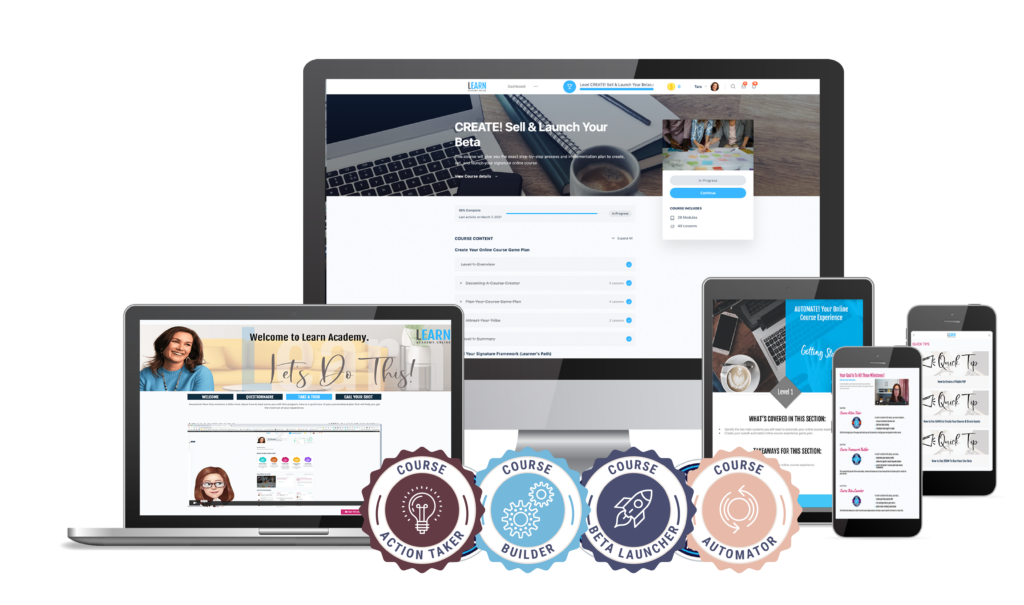You’ve spent months crafting the perfect online course. You’ve outlined every module, recorded hours of video content, and created comprehensive workbooks. You know your material inside and out. But when you launch, the response is lukewarm at best. Sound familiar?
Here’s the uncomfortable truth: No one actually wants to take your course.
This isn’t a reflection of your expertise or the quality of your content. It’s a fundamental misunderstanding of what drives people to invest their time and money in learning versus how you are approaching the online course creation process.
The Fatal Flaw in Online Course Creation
Most course creators make the same critical mistake in their online course creation process. They believe their job is to transfer information from their brain to their students’ brains. They think success means comprehensive coverage of a topic, thorough explanations of concepts, and deep dives into theory.
Many try to solve this by adding “interactivity”—clickable hotspots, interactive maps, drag-and-drop exercises, and branching scenarios. They mistake clicking for engagement and assume that because someone is moving their mouse, they’re learning more effectively.
But clicking a hotspot to reveal more information is still just information transfer. Dragging items into categories is still just information consumption with extra steps. These gratuitous interactions don’t create transformation—they create the illusion of engagement while keeping learners trapped in passive consumption mode.
This false interactivity is expensive to produce and maintains the same fundamental problem: it treats learning as information delivery rather than behavior change. Worse, it keeps learning departments positioned as cost centers rather than value drivers, stuck in a race to the bottom on pricing because they’re competing on features rather than outcomes.
Research from the eLearning Industry consistently shows that learner engagement isn’t about clicks—it’s about real-world application and measurable behavior change.
But information transfer isn’t transformation—whether it’s delivered through a video, a PDF, or a clickable infographic. And transformation is what people are actually buying.
When someone considers purchasing your course, they’re not thinking, “I really want to understand the principles of digital marketing.” They’re thinking, “I want to get more customers for my business.” They’re not seeking awareness about productivity systems—they want to stop feeling overwhelmed and start getting important work done.
This aligns with what adult learning theory has taught us for decades: people learn best when they can immediately apply new knowledge to solve real problems in their lives or work.
What People Actually Want
Your potential students want three things:
1. A specific outcome they can achieve They want to lose 20 pounds, launch their first product, or double their email list. They want concrete, measurable results that will change their life or business.
2. Confidence they can actually do it They’ve probably tried to achieve this outcome before and failed. They need to believe that this time will be different—that your approach will work for someone like them.
3. A clear path to get there They don’t want to figure out what to do next. They want you to tell them exactly what step to take today, tomorrow, and every day until they reach their goal.
Notice what’s missing from this list? Learning for learning’s sake. Understanding concepts. Gaining awareness.
The Transformation Framework
Instead of building courses around information, build them around transformation. Here’s how:
- Start with the end state. What does success look like for your student? Be specific. Instead of “understand social media marketing,” try “generate 50 qualified leads per month through LinkedIn.” Paint a picture of their life after they’ve implemented your system.
- Map the journey backward. What needs to happen right before they achieve that outcome? And before that? Keep working backward until you reach where they are today. This becomes your step-by-step path.
- Make each step actionable. Every lesson should end with a specific action your student takes in the real world—not clicking through more content. Not “think about your ideal customer” but “write a one-paragraph description of your ideal customer using this template.” Not “consider your pricing strategy” but “calculate your prices using this formula and test them with three prospects this week.”
- Anticipate and address obstacles. What will stop your students from taking action? Fear? Lack of time? Technical challenges? Build solutions to these obstacles directly into your curriculum. Consider creating a [troubleshooting guide] or [implementation checklist] as supplementary resources.
- Measure progress, not consumption. Don’t celebrate students who watch all your videos. Celebrate students who complete all your action steps. Track outcomes, not engagement metrics. Tools like Google Analytics can help you measure real business results from your course graduates.
The Mindset Shift In Online Course Creation
This requires a fundamental shift in how you think about course creation. You’re not a teacher dispensing knowledge—you’re a guide leading a transformation journey. You’re not creating content—you’re designing experiences that create change.
Your expertise isn’t just in knowing information; it’s in knowing how to help people apply that information to get results. That’s what makes you valuable. That’s what people will pay for.
The Implementation Challenge
Here’s your challenge: Look at your current course or the course you’re planning. For each module, ask yourself:
- What specific action will students take after this lesson?
- How does this action move them closer to their transformation?
- What might prevent them from taking this action, and how can I address that?
If you can’t answer these questions clearly, you’re building an information product, not a transformation product.
The Result
When you shift from information to transformation in your online course creation process, everything changes. Your marketing becomes easier because you’re selling outcomes, not features. Your students get better results because they’re focused on action, not consumption. Your business grows because satisfied customers become your best marketing channel.
The online course creation industry is saturated with information products. But there’s always demand for transformation products—courses that don’t just teach, but actually change lives.
For more insights on creating outcome-focused learning experiences, check out our guide on [measuring learning ROI] or explore [adult learning principles] that support transformation-based course design.
So ask yourself: Are you creating a course people want to take, or are you creating a transformation people want to experience?
The answer will determine whether your online course creation process succeeds or becomes another digital dust collector in someone’s downloads folder.
Ready to transform your course or program from information to transformation?
The shift starts with a single question: What does success look like for your customers? Start there, and build backward. If you want our help, schedule a call here to discuss the best place for you to begin.







